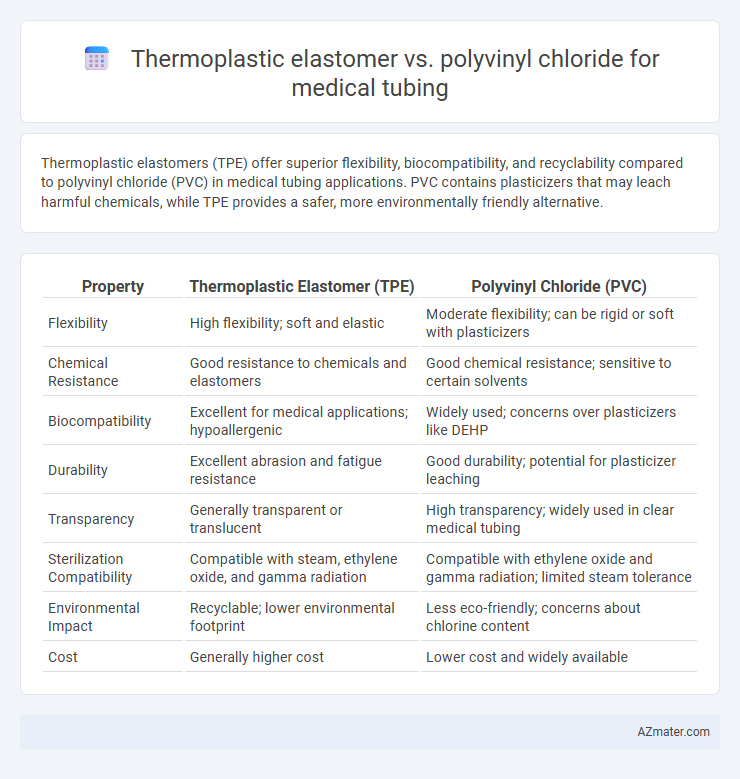Thermoplastic elastomers (TPE) offer superior flexibility, biocompatibility, and recyclability compared to polyvinyl chloride (PVC) in medical tubing applications. PVC contains plasticizers that may leach harmful chemicals, while TPE provides a safer, more environmentally friendly alternative.
Table of Comparison
| Property | Thermoplastic Elastomer (TPE) | Polyvinyl Chloride (PVC) |
|---|---|---|
| Flexibility | High flexibility; soft and elastic | Moderate flexibility; can be rigid or soft with plasticizers |
| Chemical Resistance | Good resistance to chemicals and elastomers | Good chemical resistance; sensitive to certain solvents |
| Biocompatibility | Excellent for medical applications; hypoallergenic | Widely used; concerns over plasticizers like DEHP |
| Durability | Excellent abrasion and fatigue resistance | Good durability; potential for plasticizer leaching |
| Transparency | Generally transparent or translucent | High transparency; widely used in clear medical tubing |
| Sterilization Compatibility | Compatible with steam, ethylene oxide, and gamma radiation | Compatible with ethylene oxide and gamma radiation; limited steam tolerance |
| Environmental Impact | Recyclable; lower environmental footprint | Less eco-friendly; concerns about chlorine content |
| Cost | Generally higher cost | Lower cost and widely available |
Introduction to Medical Tubing Materials
Thermoplastic elastomers (TPE) and polyvinyl chloride (PVC) are prominent materials used in medical tubing due to their flexibility, durability, and biocompatibility. TPE offers enhanced elasticity and chemical resistance, making it suitable for dynamic medical applications, while PVC provides cost-effective, rigid tubing with excellent clarity and ease of sterilization. Selection between TPE and PVC depends heavily on application-specific requirements such as flexibility, chemical exposure, and regulatory compliance in medical device manufacturing.
Overview of Thermoplastic Elastomer (TPE)
Thermoplastic elastomer (TPE) offers outstanding flexibility, biocompatibility, and resistance to kinking, making it an ideal material for medical tubing applications. Unlike polyvinyl chloride (PVC), TPE is free of phthalates and plasticizers, reducing patient risk and regulatory concerns. Its ability to be sterilized through methods like gamma irradiation and ethylene oxide further enhances its suitability in medical settings.
Overview of Polyvinyl Chloride (PVC)
Polyvinyl Chloride (PVC) is a widely used polymer in medical tubing due to its excellent chemical resistance, flexibility, and cost-effectiveness. Its inherent durability and ability to withstand sterilization processes make PVC suitable for various medical applications, including intravenous lines and catheters. However, concerns about plasticizer leaching have led to the development of alternative materials like thermoplastic elastomers for enhanced biocompatibility and performance.
Biocompatibility: TPE vs PVC
Thermoplastic elastomers (TPE) exhibit superior biocompatibility compared to polyvinyl chloride (PVC) in medical tubing applications, as TPEs are free from plasticizers like phthalates that can leach and cause adverse patient reactions. The inherent flexibility and chemical stability of TPEs reduce the risk of cytotoxicity and allergenic responses, making them ideal for long-term medical device contact. PVC tubing often requires additives to achieve desired flexibility, which can compromise biocompatibility and pose challenges in sterilization processes.
Flexibility and Durability Comparison
Thermoplastic elastomers (TPE) offer superior flexibility compared to polyvinyl chloride (PVC), making them ideal for medical tubing that requires repeated bending without cracking. TPE exhibits excellent durability by maintaining elasticity over prolonged use and resisting chemical degradation from sterilization processes. In contrast, PVC tubing tends to become brittle over time, reducing longevity and increasing the risk of failure in medical applications.
Chemical Resistance and Sterilization
Thermoplastic elastomers (TPE) offer superior chemical resistance to a wide range of aggressive solvents, oils, and pharmaceuticals compared to polyvinyl chloride (PVC), making them more suitable for medical tubing exposed to diverse chemical environments. TPE also withstands repeated sterilization cycles, including autoclaving, gamma irradiation, and ethylene oxide sterilization, without significant degradation or loss of flexibility, whereas PVC tends to become brittle and may leach plasticizers under similar conditions. The enhanced durability and biocompatibility of TPE result in safer, longer-lasting medical tubing applications where chemical exposure and sterilization are critical factors.
Environmental Impact and Sustainability
Thermoplastic elastomers (TPE) offer improved sustainability over polyvinyl chloride (PVC) in medical tubing due to their recyclability and lower environmental toxins during production. PVC releases harmful chemicals like dioxins throughout its lifecycle, posing significant ecological and health risks, while TPE materials typically generate fewer emissions and are free from phthalates. The use of TPEs aligns with growing regulatory pressures and eco-friendly initiatives in healthcare, promoting safer disposal and reduced environmental footprint.
Regulatory Compliance in Medical Applications
Thermoplastic elastomers (TPEs) offer superior regulatory compliance in medical tubing due to their biocompatibility and FDA approval for use in various medical devices, including intravenous and respiratory tubing. Polyvinyl chloride (PVC), although widely used, faces scrutiny over plasticizer leaching, prompting the need for DEHP-free alternatives to meet strict FDA and EU regulatory standards. TPEs also provide enhanced chemical resistance and sterilization compatibility, ensuring adherence to ISO 10993 biocompatibility guidelines critical in medical applications.
Cost Analysis: TPE vs PVC Tubing
Thermoplastic elastomer (TPE) tubing generally incurs higher initial material costs compared to polyvinyl chloride (PVC) tubing, driven by TPE's superior flexibility and biocompatibility properties. However, TPE's recyclability and reduced need for plasticizers can lower long-term expenses related to environmental compliance and disposal. PVC tubing remains cost-effective for large-scale production due to its established manufacturing processes and lower raw material prices, but may involve higher indirect costs linked to potential phthalate-related health concerns and regulatory restrictions.
Future Trends in Medical Tubing Materials
Thermoplastic elastomers (TPEs) and polyvinyl chloride (PVC) are pivotal in medical tubing, with TPEs gaining traction due to their enhanced biocompatibility, flexibility, and recyclability. Future trends emphasize the development of eco-friendly, non-toxic materials with improved sterilization resistance, where TPEs are favored for their reduced environmental impact compared to traditional PVC formulations containing phthalates. Innovations in polymer blends and nanocomposites aim to optimize mechanical properties and chemical stability, driving the shift toward TPE-based medical tubing in next-generation healthcare applications.

Infographic: Thermoplastic elastomer vs Polyvinyl chloride for Medical tubing
 azmater.com
azmater.com